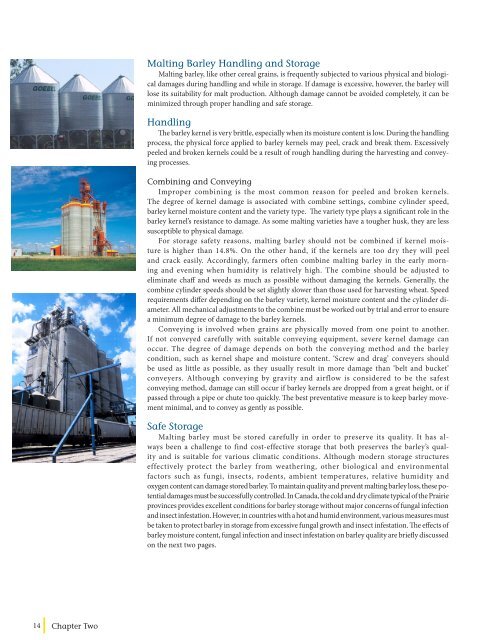MALTING QUALITY TRAITS - Canadian Malting Barley Technical ...
MALTING QUALITY TRAITS - Canadian Malting Barley Technical ...
MALTING QUALITY TRAITS - Canadian Malting Barley Technical ...
Create successful ePaper yourself
Turn your PDF publications into a flip-book with our unique Google optimized e-Paper software.
14<br />
Chapter Two<br />
<strong>Malting</strong> <strong>Barley</strong> Handling and Storage<br />
<strong>Malting</strong> barley, like other cereal grains, is frequently subjected to various physical and biological<br />
damages during handling and while in storage. If damage is excessive, however, the barley will<br />
lose its suitability for malt production. Although damage cannot be avoided completely, it can be<br />
minimized through proper handling and safe storage.<br />
Handling<br />
The barley kernel is very brittle, especially when its moisture content is low. During the handling<br />
process, the physical force applied to barley kernels may peel, crack and break them. Excessively<br />
peeled and broken kernels could be a result of rough handling during the harvesting and conveying<br />
processes.<br />
Combining and Conveying<br />
Improper combining is the most common reason for peeled and broken kernels.<br />
The degree of kernel damage is associated with combine settings, combine cylinder speed,<br />
barley kernel moisture content and the variety type. The variety type plays a significant role in the<br />
barley kernel’s resistance to damage. As some malting varieties have a tougher husk, they are less<br />
susceptible to physical damage.<br />
For storage safety reasons, malting barley should not be combined if kernel moisture<br />
is higher than 14.8%. On the other hand, if the kernels are too dry they will peel<br />
and crack easily. Accordingly, farmers often combine malting barley in the early morning<br />
and evening when humidity is relatively high. The combine should be adjusted to<br />
eliminate chaff and weeds as much as possible without damaging the kernels. Generally, the<br />
combine cylinder speeds should be set slightly slower than those used for harvesting wheat. Speed<br />
requirements differ depending on the barley variety, kernel moisture content and the cylinder diameter.<br />
All mechanical adjustments to the combine must be worked out by trial and error to ensure<br />
a minimum degree of damage to the barley kernels.<br />
Conveying is involved when grains are physically moved from one point to another.<br />
If not conveyed carefully with suitable conveying equipment, severe kernel damage can<br />
occur. The degree of damage depends on both the conveying method and the barley<br />
condition, such as kernel shape and moisture content. ‘Screw and drag’ conveyers should<br />
be used as little as possible, as they usually result in more damage than ‘belt and bucket’<br />
conveyers. Although conveying by gravity and airflow is considered to be the safest<br />
conveying method, damage can still occur if barley kernels are dropped from a great height, or if<br />
passed through a pipe or chute too quickly. The best preventative measure is to keep barley movement<br />
minimal, and to convey as gently as possible.<br />
Safe Storage<br />
<strong>Malting</strong> barley must be stored carefully in order to preserve its quality. It has always<br />
been a challenge to find cost-effective storage that both preserves the barley’s quality<br />
and is suitable for various climatic conditions. Although modern storage structures<br />
effectively protect the barley from weathering, other biological and environmental<br />
factors such as fungi, insects, rodents, ambient temperatures, relative humidity and<br />
oxygen content can damage stored barley. To maintain quality and prevent malting barley loss, these potential<br />
damages must be successfully controlled. In Canada, the cold and dry climate typical of the Prairie<br />
provinces provides excellent conditions for barley storage without major concerns of fungal infection<br />
and insect infestation. However, in countries with a hot and humid environment, various measures must<br />
be taken to protect barley in storage from excessive fungal growth and insect infestation. The effects of<br />
barley moisture content, fungal infection and insect infestation on barley quality are briefly discussed<br />
on the next two pages.


